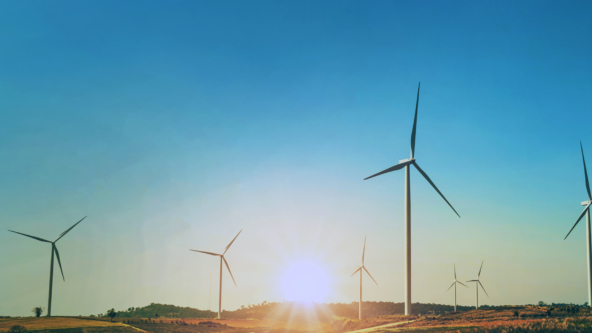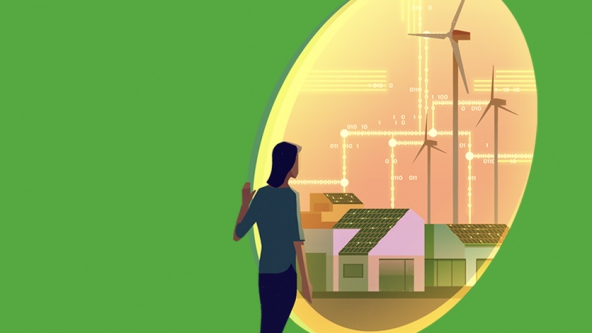Solar energy is the world’s fastest-growing energy source, and for good reason. Abundant, sustainable, and cheaper than coal (and predicted to beat gas and nuclear by 2022), solar is bringing about big changes around the globe.
In the UK alone, solar energy accounted for 12.6% of all renewable energy generation in 2016 – a 25% increase on 2015 figures. And, right now, the UK is generating 12,756 MW of solar energy. That’s enough to power nearly four million homes.
However, despite the increasing adoption of solar, it’s still a widely misunderstood resource. With that in mind, let’s explore how solar energy works and how it’s going to change the UK economy for the better.
What is solar energy?
A brief history
Solar energy has always been an important resource for humans. As early as 6000 BC, the Chinese designed their homes to capture the warmth of the sun. By 1000 BC, the Romans and Chinese were concentrating solar energy with “burning mirrors” to light fires and torches. Later, solar energy was used in solar ovens to cook food, to heat water, and in greenhouses to grow exotic fruits and vegetables in cooler climes.
Then in 1839, a new application emerged that would change how we think about solar energy forever. Alexander Edmond Becquerel (1820-1891) discovered that sunlight created an electrical current between silver chloride and platinum. The photovoltaic effect, as it came to be known, was further developed by Willoughby Smith (1828-1891), who discovered selenium’s greater conductivity in the presence of light.
Building upon these discoveries, Charles Fritts built the first selenium-based solar module in 1883. However, selenium wasn’t a particularly efficient photovoltaic material. It wasn’t until Bell Laboratories in the US began experimenting with silicon in the 1950s that the first solar cell appeared, paving the way for a new generation of solar panels that could power everyday appliances.
How does solar energy work?
Earth’s most powerful ally
Solar energy is the result of nuclear fusion inside the sun’s core. Like all stars, the core smashes lighter elements together to form heavier ones. In our sun’s case, this is the fusion of hydrogen into helium. As they fuse, the reaction releases enormous amounts of energy, heating the core to 15.6 million degrees celsius.
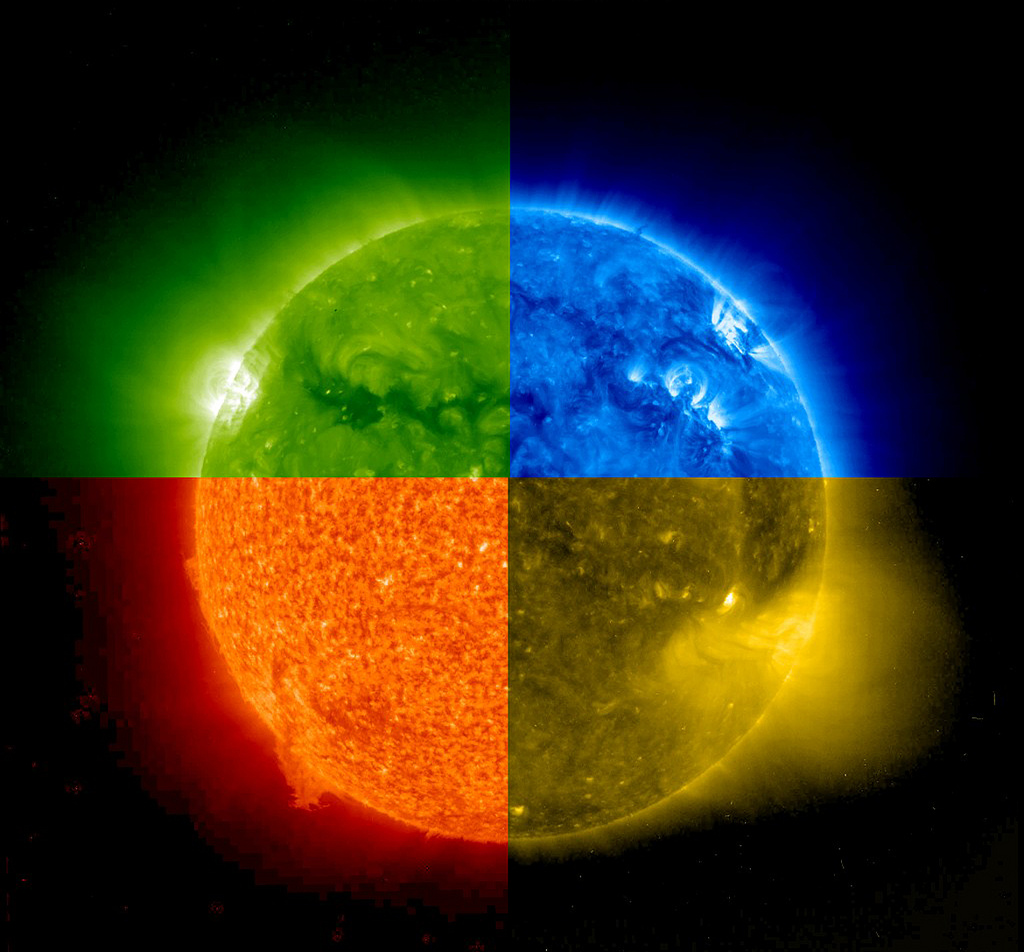
A composite image of the sun taken at different wavelengths. © NASA
At the surface, the sun releases this energy at around 63 million W/m2, which blasts its way towards Earth at the speed of light, finally reaching Earth after about eight minutes. By the time it hits our upper atmosphere, much of the energy is lost, and we receive about 1370 W/m2.
That’s still a dangerous amount of energy (as anyone with bad sunburn will tell you), and without our atmosphere protecting us from the worst of the sun’s power, our oceans would evaporate and life would die out. Thankfully, the atmosphere attenuates solar energy to a degree that’s safe and enables life to flourish.
A force for good
Following Becquerel’s discovery, the world went dizzy with dreams of endless, free power. While we’ve not reached those utopian heights yet, we can capture a proportion of that solar energy and convert it into heat and electricity using solar panels. NASA and other space agencies have been doing it for years, powering satellites and spacecraft without the need for heavy generators or fuel tanks.
Broadly speaking, there are two types of solar panel, thermal and photovoltaic. Thermal panels capture sunlight and turn it into heat. Photovoltaic panels capture sunlight and convert it to electricity. So how does each type of solar panel work?
Thermal panels
Over 70% of the energy we use is for heating our homes and businesses, therefore thermal panels are an excellent, inexpensive way to cut your energy use. Each thermal system varies, but they work on a similar principle.
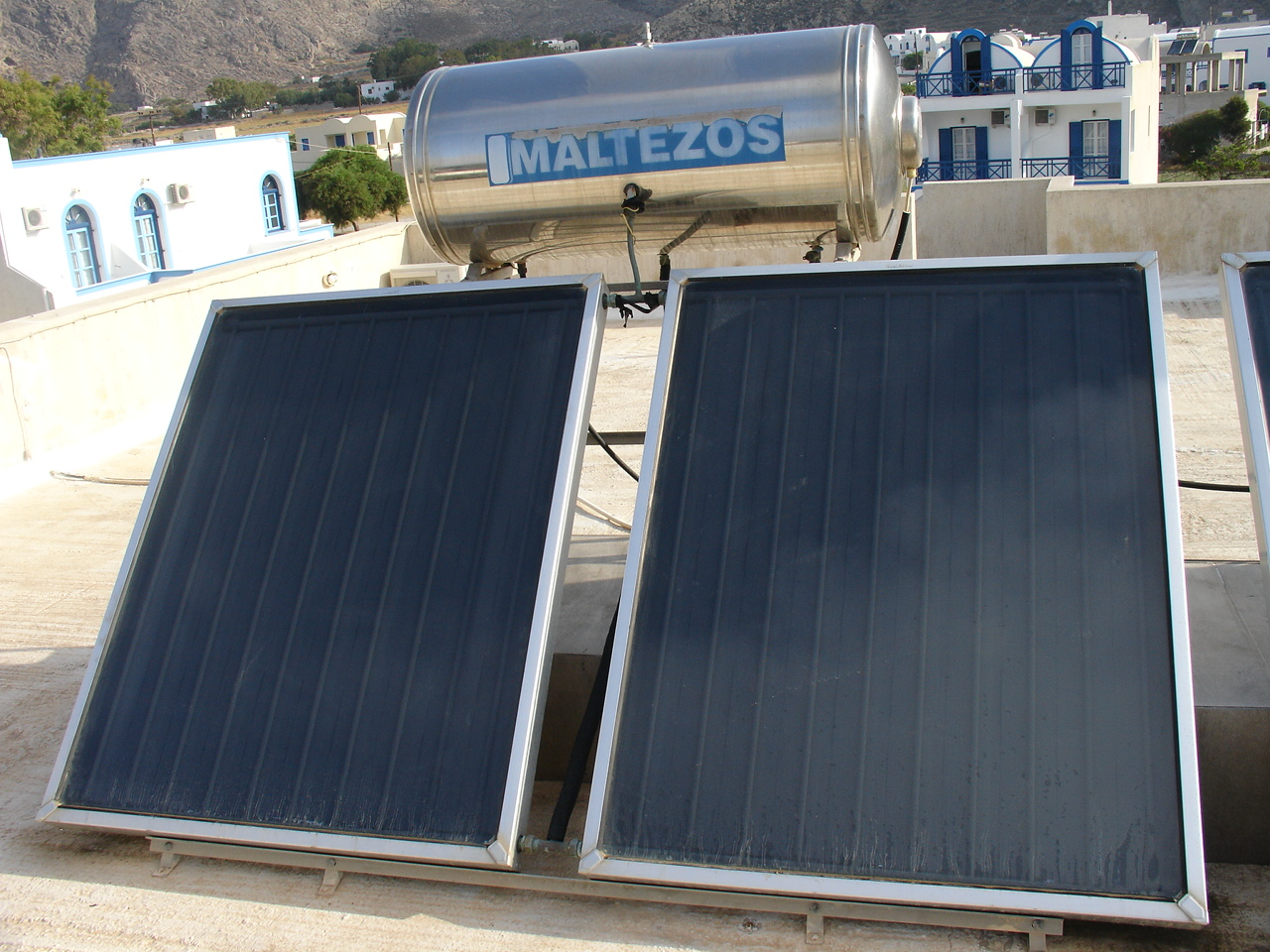
“Flat plate” thermal panels

“Evacuated tubes” thermal panel
First, a solar collector captures sunlight and converts it to heat. If it’s a liquid-based system, the solar collector is either a flat plate of insulated copper pipes or a series of evacuated tubes.
The solar collector transfers heat to a liquid within the pipes or tubes, which then enters central heating or plumbing systems via a hot water tank. Newly-cooled liquid is then pumped back to the solar collector for reheating. The pump itself can be powered by a solar photovoltaic panel, making it even more energy efficient.
In an air-based system, the solar collector heats air which is then redistributed throughout the building using fans.
Photovoltaic panels
A photovoltaic panel is a collection of modules, themselves comprised of photovoltaic cells. Each cell contains semiconducting material, usually silicon, and when light hits the silicon, electrons are knocked out of the silicon atoms. The free electrons, under the influence of a negative and positive electric field in the silicon, are then drawn from one side to the other, creating a current.
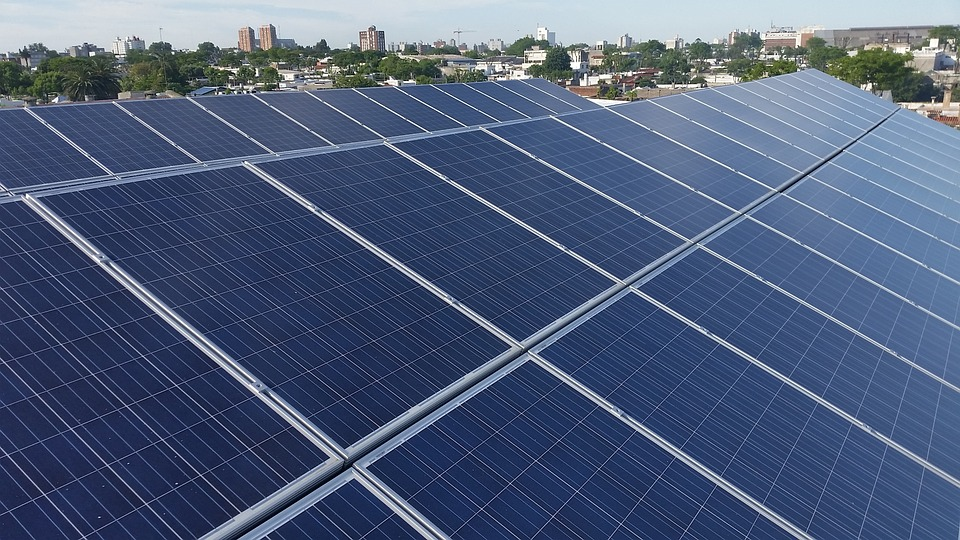
A solar PV array consisting of panels of connected solar modules
Photovoltaic cells are bound together in modules, and modules are wired together to form arrays. Solar farms consist of several solar arrays. The combined electricity output of the solar farm then enters the grid where it’s distributed to homes and businesses throughout the UK.
Thermal vs Photovoltaic
Photovoltaic panels aren’t as efficient as thermal panels, reaching about 25-30% in the most expensive models, while thermal panels operate between 50% and 70%. But we can do a lot more with electricity than we can with heat, so the panels are an extremely important ingredient of a decarbonised economy. Also, they tend to last longer and require less maintenance than thermal panels.
Commercial solar farms normally use inexpensive arrays of 10-20% efficiency to ensure an acceptable cost-benefit ratio. One of Octopus Energy’s solar farms, for example, in Molland, Devon, uses an array of 12% efficiency, but that’s more than enough to power 12,000 homes at peak output of 5MW.
What are the advantages of solar energy?
Cleaner power, cleaner air
Solar energy is abundant, free, and sustainable – ideal for generating electricity. As signs of global warming become more prominent and frequent, solar energy helps us keep the lights on without disrupting the planet’s climate.
Fossil fuels upset the natural carbon cycle, as well as polluting our ecosystems. Excess CO2 in our atmosphere is melting polar ice, increasing desertification, and causing more extreme weather like floods, droughts, and hurricanes. And according to a new report in The Lancet, pollution causes 50,000 deaths in the UK every year – mainly from industry and transport.
One of the key benefits of solar energy is that it doesn’t release greenhouse gases or pollutants. While panel installation and manufacture produce a small amount, it’s more than compensated for once panels are operational. In fact, if the UK generated solar electricity exclusively, we’d remove 25% of our greenhouse gas emissions for good.
Stable, secure, and cheaper energy
Another advantage of solar energy is that it frees us from a volatile fuel market. Relying on fossil fuels exposes us to wholesale prices that vary according to supply and demand. This leaves us at the mercy of social, economic, and political forces outside of our control.
All EU countries are net importers of energy, so we’re vulnerable to price rises when something disrupts the supply chain. Conflict, regulations, and leadership changes can all drive up the price of resources bought from that country.
Many energy suppliers hedge against rises by buying wholesale energy in advance (often up to two or three years). By insuring against rises they hope to protect their market share, but this comes at a premium which is passed on to the customer through their energy bills. If the wholesale price goes down or stays the same, customers also lose out.
Having our own supply of solar energy means we don’t need to rely on imported fossil fuels for generation. Nor do we need to import electricity from nearby countries, or pay a hedging premium against rises. Instead, we have a reasonably predictable source of free energy that doesn’t swing with market moods – resulting in much lower bills.
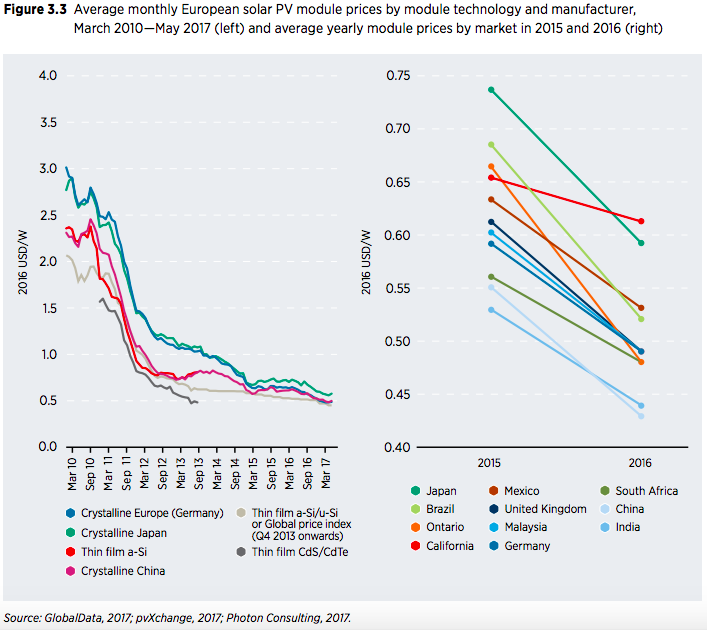
Average monthly European solar PV module prices by module technology and manufacturer, March 2010—May 2017 (left) and average yearly module prices by market in 2015 and 2016 (right). Copyright © IRENA 2018
The cost to generate solar electricity has fallen substantially in the last few decades. Solar and wind have already achieved grid parity (the point at which the cost to generate renewable energy matches or falls below that of conventional methods), and by 2020, IRENA predicts they’ll be even cheaper.
Indeed, you can buy renewable energy cheaper than many Big Six Standard Variable Tariffs (SVTs). In London, for example, you’d pay just 13.9p per kWh for Octopus Energy’s Green tariff, but 16p per kWh for Scottish Power’s Online Standard tariff. So in many cases, fossil fuels aren’t just bad for your health and the environment, but also your pocket.
“Solar power has become the key energy source of the future because its success in scaling has driven down cost, making it increasingly viable around the world without the need for government subsidies. It is therefore great for the environment and for consumers.”
Matt Setchell, Head of Renewables, Octopus Investments
Equally, if the UK relies on a distributed network of solar energy, and not a small number of centralised coal or gas power stations, blackouts, brownouts, and power surges will affect fewer people. Energy can just be rerouted from another local site. And in times of conflict, having our own supply of solar power defangs any potential attack on energy sources, overt or otherwise.
A lucrative, sustainable economy
Solar energy boosts the economy by creating jobs. From panel manufacturers to installation engineers, solar power needs talented minds to fulfill its potential in the UK. Already the solar industry employs almost 126,000 people, growing every year to meet both private and public demand for solar energy. The oil and gas industry, on the other hand, has been cutting jobs every year since 2013.
At present, the Government’s support of fossil fuels far outweighs that of renewables. Using figures from the Organisation for Economic Co-operation and Development (OECD), Carbon Brief estimates financial aid of between “$5.8bn and $7bn since 2010.”
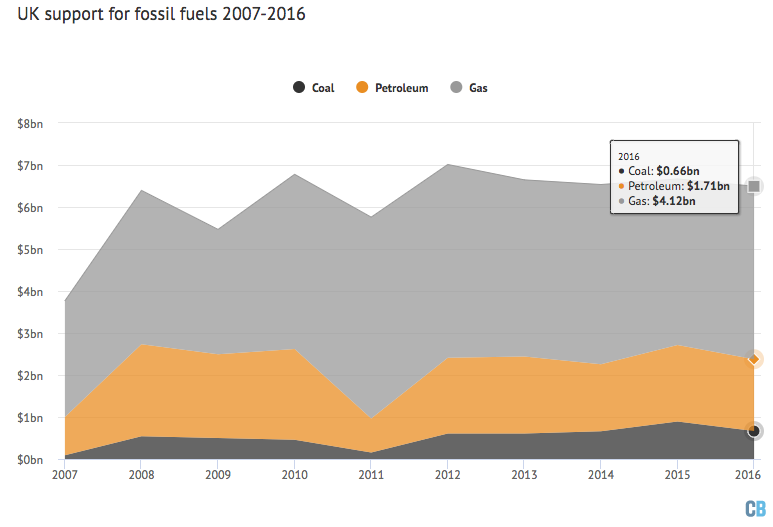
Instead of propping up a failing, destructive, and expensive energy source, the government could allow the market to determine the best source of power. This would free up billions of pounds to spend on more deserving causes like schools, hospitals, and infrastructure.
The Government has already withdrawn much of its subsidy support for solar electricity, yet it continues to grow. The UK’s first ever subsidy-free solar farm opened in 2017, and analysts predict solar will thrive independently by 2025.
As the UK’s largest investor in solar farms, Octopus has helped develop over a hundred different sites, many of which generate electricity on behalf of Octopus Energy customers.
“Octopus led the roll-out of solar energy generation in the UK back in 2011,, and remains the largest solar owner/operator in the UK. We manage our assets alongside a growing portfolio of other renewable energy sources, including onshore wind and biomass. By managing these assets together, and using cutting edge technology from Reactive Technologies, we can improve performance for our investors and attract further investment into UK solar.”
Matt Setchell, Octopus Renewables.
A thriving ecosystem
You don’t have to look hard to see how climate change is wreaking havoc on the animal kingdom. Not only is it destroying natural habitats, but it’s disrupting populations, reducing their size or pushing them to new places. This is making it increasingly difficult for animals to find food, shelter, and mates with which to reproduce.
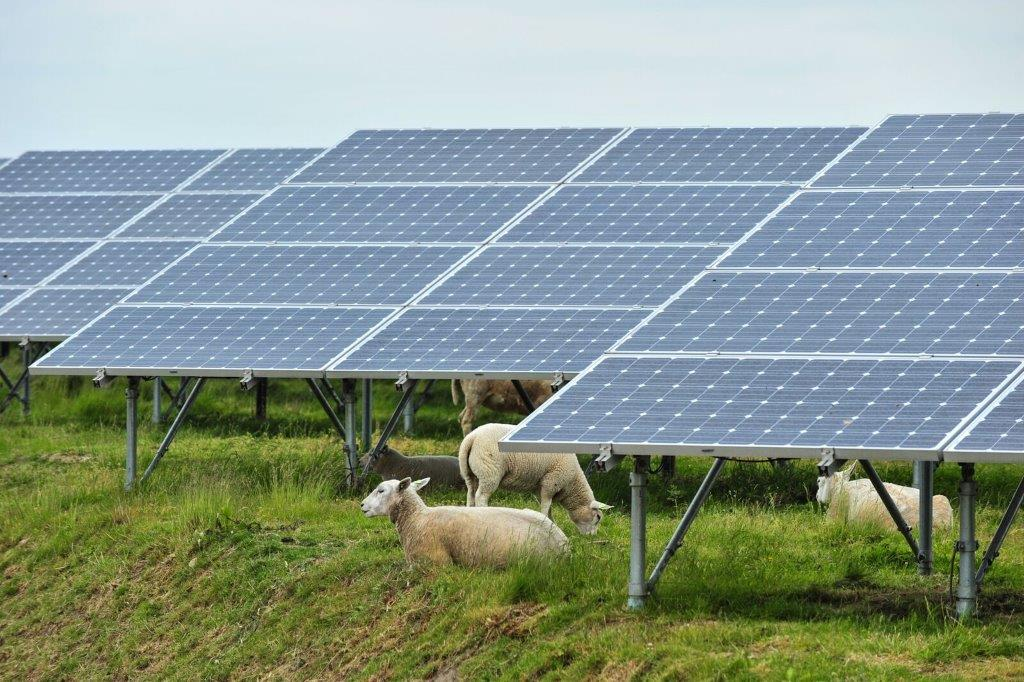
Sheep enjoying the shade
As well as coexisting peacefully with grazing animals, solar farms encourage biodiversity by creating safe havens where bees, insects, and other animals can nest. The UK’s bee populations are already in decline and solar farms could help them bounce back.
Also, by creating a second income for farmers, solar farms protect swathes of countryside from over-cultivation. If farmers can exploit brownland, or other poor quality land, they won’t intensify farming of other pastures. Solar panels are therefore a lucrative, eco-friendly choice for land that might otherwise have gone to waste.
Does the UK have enough solar energy?
The UK used 357 TWh of electricity in 2016. It’s unlikely we could ever meet such demand with solar power alone, given our distance from the equator and cloudy weather, but solar has proven more than capable of bearing a significant share.
How much solar energy do we receive?
In his book Sustainable Energy – Without the Hot Air, David J C MacKay estimates the UK receives an average of 100 W/m2 for flat land and 110 W/m2 for south-facing roofs from the sun in a typical year. This takes into account our seasons, weather, geographical location, and the time of day.
But this is a measure of solar power (the rate of energy produced), and we’re interested in solar energy (the amount of energy we receive). So the calculation becomes:
Flat land
Energy = power x time
Energy = 100 x (365 x 24)
Energy = 876,000 Wh/m²
Energy = 876 kWh/m²/year
South-facing roofs
Energy = power x time
Energy = 110 x (365 x 24)
Energy = 964,000 Wh/m²
Energy = 964 kWh/m²/year
Is that enough solar energy for a typical household?
At first glance, based on our calculations above, a typical household using 3,100 kWh in a year would need around 3m2 of solar panels. However, as noted previously, PV panels aren’t 100% efficient. The SunPower X22 domestic solar panel, for example, one of the most efficient on the market, is rated at 22.8%, so really you’d need around 14m2.
Depending on the size of your property, you could conceivably generate enough solar electricity for all your needs (provided you had a means to store it). Or at the very least, a sizeable proportion of them. For people living in flats and smaller properties, or who can’t afford solar panels, your easiest option is to choose a 100% renewable electricity energy supplier.
One of solar energy’s biggest benefits is protecting biodiversity. By reducing greenhouse gas emissions, cohabiting with existing species, and protecting declining populations, solar energy can help animals thrive.

Electricity generated by Octopus Energy in December and June (2016)
Octopus Energy generates electricity from a large portfolio of solar, wind, and anaerobic digestion sites. This ensures that no matter what the weather, season, or time of day, Octopus Energy guarantees to replace every kWh used by their Green tariff customers with a renewable one.
As you can see from the graph above, anaerobic digestion compensates for fewer hours of sunshine in December. But during the summer months, Octopus Energy generates so much solar electricity it can supply its non-green customers, too. In 2016, for example, 69% of all Octopus Energy electricity was renewable – almost triple that of the national average.
What happens when it’s dark?
To really take advantage of solar energy, we must be able to store it. Not just for when the sun sets, but when we’re generating more or less than we need. There are lots of storage technologies available, from batteries to pumped hydro, and we’ll need to use a complement of solutions to ensure the lights stay on long after the sun has gone down.
This Kiwi Power facility in Wales, for example, stores solar energy in Tesla lithium-ion batteries. When the grid is full and can’t draw power from the panels, the batteries charge. As soon as the sun sets, or the grid experiences a shortage, the batteries discharge.
This also works at the domestic level. Tesla’s PowerWall – a home battery for use with domestic solar systems – also uses lithium-ion technology and can generate 13.5 kWh from a full charge. Your electric vehicle battery could function in the same way – charging or discharging according to your driving schedule and the grid’s status.
Whichever storage portfolio we choose, open competition and innovation will determine the winners. Whether its demand-side response or grid-scale battery plants, storage will allow the benefits of solar energy to penetrate every aspect of society.
The future of solar energy
As solar energy costs continue to fall, the UK is in prime position to meet its 2020 renewable targets and beyond. To fully realise the potential of solar energy, and secure it as an independent energy source for the future, we need better data and management systems to ensure each element of the solar journey is efficient and effective.
We need sensing and monitoring equipment that helps us better understand how much solar energy is being generated, where it’s coming from, and how much is being used. We need to identify and predict generation and demand patterns, and implement a sophisticated response mechanism to manage them.
Reactive Technologies, an Octopus partner, is working to improve the quality of grid data to help National Grid balance a decentralised, intermittent source like solar. As such innovation continues, the future of solar energy looks bright – and so, therefore, does ours.

